Distribution, Sources, and Ecological Risk Assessment of Potentially Toxic Elements in Surface Sediments of Dongzhai Harbor, Hainan Island, China
Abstract
:1. Introduction
2. Study Area
3. Materials and Methods
3.1. Sediment Collection and Analysis
3.2. Pollution Assessment
4. Results and Discussion
4.1. Sediment Type
4.2. Content and Distributions of PTEs
| Locations | Cu | Pb | Zn | Cr | Cd | Ni | As | References |
|---|---|---|---|---|---|---|---|---|
| Dongzhai Harbor | 14.07 | 20.63 | 55.01 | 53.24 | 0.066 | 20.03 | 5.18 | This study |
| 4.85–36.33 | 8.84–36.61 | 20.3–113.9 | 18–119.9 | 0.018–0.155 | 4.96–52.06 | 1.97–11.56 | ||
| The eastern continental shelf of Hainan Island | 29.4 | 19.2 | 81.4 | 57.3 | 0.19 | 25.6 | 7.6 | [11] |
| Nandu River | 9.32 | 16,6 | 30.1 | 29.1 | 0.08 | 14.5 | 3.73 | [13] |
| Qizhou Island | 11.31 | 21.02 | 55.38 | 47.45 | 0.091 | 21.55 | NA | [12] |
| Beibu Bay | 58.26 | 27.99 | 67.28 | 53.65 | 0.16 | NA | 9.53 | [14] |
| Khnifiss Lagoon National Park (Morocco) | 12.5 | 12.1 | 41.0 | 52.2 | 0.35 | 25.9 | 12.6 | [31] |
| Anzali coastal wetland | 47.02 | 20.93 | 112.64 | 104.85 | 0.78 | 52.37 | 18.28 | [30] |
| Deep soil sediments in Hainan | 20 | 29.2 | 58.9 | 65.2 | 0.06 | 29.9 | 5.5 | [26] |
| ERM | 270 | 218 | 410 | 370 | 9.6 | 51.6 | 0.71 | [28] |
| ERL | 34 | 46.7 | 150 | 81 | 1.2 | 20.9 | 0.15 | [28] |
| MSQ I | ≤35 | ≤60 | ≤150 | ≤80 | ≤0.5 | ≤60 | ≤20 | [29] |
| MSQ II | ≤100 | ≤130 | ≤350 | ≤150 | ≤1.5 | NA | ≤65 |
4.3. Contamination Factor
4.4. Geoaccumulation Index
4.5. Ecological Risk Assessment
4.6. Health Risk Assessment
4.7. Sources of PTEs
4.7.1. Pearson Correlation Analysis
4.7.2. Hierarchical Cluster Analysis
5. Conclusions
Author Contributions
Funding
Data Availability Statement
Conflicts of Interest
References
- Fan, Y.; Chen, X.; Chen, Z.; Zhou, X.; Lu, X.; Liu, J. Pollution characteristics and source analysis of heavy metals in surface sediments of Luoyuan Bay, Fujian. Environ. Res. 2022, 203, 111911. [Google Scholar] [CrossRef] [PubMed]
- Xu, F.; Tian, X.; Yin, F.; Zhao, Y.; Yin, X. Heavy metals in the surface sediments of the northern portion of the South China Sea shelf: Distribution, contamination, and sources. Environ. Sci. Pollut. Res. 2016, 23, 8940–8950. [Google Scholar] [CrossRef]
- Pan, K.; Wang, W.-X. Trace metal contamination in estuarine and coastal environments in China. Sci. Total. Environ. 2012, 421-422, 3–16. [Google Scholar] [CrossRef] [PubMed]
- Qiu, Y.-W.; Yu, K.-F.; Zhang, G.; Wang, W.-X. Accumulation and partitioning of seven trace metals in mangroves and sediment cores from three estuarine wetlands of Hainan Island, China. J. Hazard. Mater. 2011, 190, 631–638. [Google Scholar] [CrossRef]
- Yi, S.; Song, Z.; Lin, J.; Liu, W.; Li, B. Distribution, sources and influencing factors of heavy metals in the Ledong Sea, South China Sea. Mar. Pollut. Bull. 2024, 202, 116396. [Google Scholar] [CrossRef]
- Wang, M.; Chen, Q.; Cui, J.; Yu, Z.; Wang, W.; Sun, Z.; Chen, Q. Distribution, ecological risk, and sediment-influencing mechanisms of heavy metals in surface sediments along the intertidal gradient in typical mangroves in Hainan, China. Mar. Pollut. Bull. 2024, 206, 116677. [Google Scholar] [CrossRef]
- Xu, F.; Hu, B.; Zhao, J.; Liu, X.; Xu, K.; Xiong, Z.; Wang, F.; Ding, X.; Li, Q.; Guo, J. Provenance and weathering of sediments in the deep basin of the northern South China Sea during the last 38 kyr. Mar. Geol. 2021, 440, 106602. [Google Scholar] [CrossRef]
- Xu, F.; Zhang, X.; Xu, J.; Sun, Z.; Yuan, S.; Liu, X. Sea level and low-latitude climate control on sedimentary provenance and paleoenvironmental evolution in the central Okinawa Trough since 19 cal. ka BP. Palaeogeogr. Palaeoclim. Palaeoecol. 2025, 658, 112621. [Google Scholar] [CrossRef]
- Li, P.; Li, X.; Bai, J.; Meng, Y.; Diao, X.; Pan, K.; Zhu, X.; Lin, G. Effects of land use on the heavy metal pollution in mangrove sediments: Study on a whole island scale in Hainan, China. Sci. Total. Environ. 2022, 824, 153856. [Google Scholar] [CrossRef]
- Zhang, J.; Wang, D.R.; Jennerjahn, T.; Dsikowitzky, L. Land–sea interactions at the east coast of Hainan Island, South China Sea: A synthesis. Cont. Shelf Res. 2013, 57, 132–142. [Google Scholar] [CrossRef]
- Xu, F.; Tian, X.; Yin, X.; Yan, H.; Yin, F.; Liu, Z. Trace metals in the surface sediments of the eastern continental shelf of Hainan Island: Sources and contamination. Mar. Pollut. Bull. 2015, 99, 276–283. [Google Scholar] [CrossRef] [PubMed]
- Fan, J.; Zhang, L.; Wang, A.; Meng, X.; Xu, C.; Wang, X.; Wang, S.; Huang, W.; Xu, F. Distribution, sources, and contamination evaluation of heavy metals in surface sediments of the Qizhou Island sea area in Hainan, China. Mar. Pollut. Bull. 2024, 208, 116933. [Google Scholar] [CrossRef]
- Sun, Y.; Yang, J.; Gong, J.; Duan, Z. Contamination and source of metals in surface sediments from the Nandu River of Hainan Island, China. Mar. Pollut. Bull. 2022, 182, 114037. [Google Scholar] [CrossRef] [PubMed]
- Dou, Y.; Li, J.; Zhao, J.; Hu, B.; Yang, S. Distribution, enrichment and source of heavy metals in surface sediments of the eastern Beibu Bay, South China Sea. Mar. Pollut. Bull. 2013, 67, 137–145. [Google Scholar] [CrossRef]
- Zhang, L.; Ni, Z.; Cui, L.; Li, J.; He, J.; Jiang, Z.; Huang, X. Heavy metal accumulation and ecological risk on four seagrass species in South China. Mar. Pollut. Bull. 2021, 173, 113153. [Google Scholar] [CrossRef] [PubMed]
- Hao, Z.; Qian, J.; Zheng, F.; Lin, B.; Xu, M.; Feng, W.; Zou, X. Human-influenced changes in pollution status and potential risk of sediment heavy metals in Xincun Bay, a typical lagoon of Hainan, China. Mar. Pollut. Bull. 2024, 199, 115949. [Google Scholar] [CrossRef]
- Liu, B.; Xia, P.; Du, J.; Luo, X.; Zhai, R.; Lin, J. Sedimentary records of environmental evolution in Dongzhai Port mangrove swamps (South China) over the last hundred years: Insights from corrections of grain-size effects. Environ. Pollut. 2024, 343, 123179. [Google Scholar] [CrossRef]
- Guo, Y.; Ke, X.; Zhang, J.; He, X.; Li, Q.; Zhang, Y. Distribution, Risk Assessment and Source of Heavy Metals in Mangrove Wetland Sediments of Dongzhai Harbor, South China. Int. J. Environ. Res. Public Health 2023, 20, 1090. [Google Scholar] [CrossRef]
- Zhang, G.; Chen, S.; Long, R.; Ma, B.; Chang, Y.; Mao, C. Distribution of Heavy Metals in Surface Sediments of a Tropical Mangrove Wetlands in Hainan, China, and Their Biological Effectiveness. Minerals 2023, 13, 1476. [Google Scholar] [CrossRef]
- Håkanson, L. An ecological risk index for aquatic pollution control. A sedimentological approach. Water Res. 1980, 14, 975–1001. [Google Scholar] [CrossRef]
- Tomlinson, D.L.; Wilson, J.G.; Harris, C.R.; Jeffrey, D.W. Problems in the assessment of heavy-metal levels in estuaries and the formation of a pollution index. Helgoländer Meeresunters. 1980, 33, 566–575. [Google Scholar] [CrossRef]
- Al-Hashim, M.H.; El-Sorogy, A.S.; Al Qaisi, S.; Alharbi, T. Contamination and ecological risk of heavy metals in Al-Uqair coastal sediments, Saudi Arabia. Mar. Pollut. Bull. 2021, 171, 112748. [Google Scholar] [CrossRef] [PubMed]
- Zhuang, Q.; Li, G.; Liu, Z. Distribution, source and pollution level of heavy metals in river sediments from South China. CATENA 2018, 170, 386–396. [Google Scholar] [CrossRef]
- Wang, F.; Guan, Q.; Tian, J.; Lin, J.; Yang, Y.; Yang, L.; Pan, N. Contamination characteristics, source apportionment, and health risk assessment of heavy metals in agricultural soil in the Hexi Corridor. CATENA 2020, 191, 104573. [Google Scholar] [CrossRef]
- Hu, B.; Cui, R.; Li, J.; Wei, H.; Zhao, J.; Bai, F.; Song, W.; Ding, X. Occurrence and distribution of heavy metals in surface sediments of the Changhua River Estuary and adjacent shelf (Hainan Island). Mar. Pollut. Bull. 2013, 76, 400–405. [Google Scholar] [CrossRef]
- He, Y.S.; Zhang, G.C.; Xue, G.C.; Guo, Y.P. Handbook of Soil Geochemistry on Hainan Island; China University of Geosciences Press: Wuhan, China, 2021. [Google Scholar]
- Cai, P.; Cai, G.; Yang, J.; Li, X.; Lin, J.; Li, S.; Zhao, L. Distribution, risk assessment, and quantitative source apportionment of heavy metals in surface sediments from the shelf of the northern South China Sea. Mar. Pollut. Bull. 2023, 187, 114589. [Google Scholar] [CrossRef]
- Long, E.R.; Macdonald, D.D.; Smith, S.L.; Calder, F.D. Incidence of adverse biological effects within ranges of chemical concentrations in marine and estuarine sediments. Environ. Manag. 1995, 19, 81–97. [Google Scholar] [CrossRef]
- GB 18668-2002; The PeoplE’s Republic of China National Standards—Marine Sediment Quality. CSBTS: Beijing, China, 2002.
- Zarei, S.; Karbassi, A.; Sadrinasab, M.; Sarang, A. Investigating heavy metal pollution in Anzali coastal wetland sediments: A statistical approach to source identification. Mar. Pollut. Bull. 2023, 194, 115376. [Google Scholar] [CrossRef]
- Tnoumi, A.; Angelone, M.; Armiento, G.; Caprioli, R.; Crovato, C.; De Cassan, M.; Montereali, M.R.; Nardi, E.; Parrella, L.; Proposito, M.; et al. Heavy metal content and potential ecological risk assessment of sediments from Khnifiss Lagoon National Park (Morocco). Environ. Monit. Assess. 2022, 194, 356. [Google Scholar] [CrossRef]
- Duodu, G.O.; Goonetilleke, A.; Ayoko, G.A. Comparison of pollution indices for the assessment of heavy metal in Brisbane River sediment. Environ. Pollut. 2016, 219, 1077–1091. [Google Scholar] [CrossRef]
- Ip, C.C.; Li, X.-D.; Zhang, G.; Wai, O.W.; Li, Y.-S. Trace metal distribution in sediments of the Pearl River Estuary and the surrounding coastal area, South China. Environ. Pollut. 2007, 147, 311–323. [Google Scholar] [CrossRef] [PubMed]
- Zhang, L.; Ye, X.; Feng, H.; Jing, Y.; Ouyang, T.; Yu, X.; Liang, R.; Gao, C.; Chen, W. Heavy metal contamination in western Xiamen Bay sediments and its vicinity, China. Mar. Pollut. Bull. 2007, 54, 974–982. [Google Scholar] [CrossRef] [PubMed]
- Lin, S.; Hsieh, I.-J.; Huang, K.-M.; Wang, C.-H. Influence of the Yangtze River and grain size on the spatial variations of heavy metals and organic carbon in the East China Sea continental shelf sediments. Chem. Geol. 2002, 182, 377–394. [Google Scholar] [CrossRef]
- Liang, J.; Liu, J.; Xu, G.; Chen, B. Distribution and transport of heavy metals in surface sediments of the Zhejiang nearshore area, East China Sea: Sedimentary environmental effects. Mar. Pollut. Bull. 2019, 146, 542–551. [Google Scholar] [CrossRef]
- Xiao, H.; Shahab, A.; Ye, F.; Wei, G.; Li, J.; Deng, L. Source-specific ecological risk assessment and quantitative source apportionment of heavy metals in surface sediments of Pearl River Estuary, China. Mar. Pollut. Bull. 2022, 179, 113726. [Google Scholar] [CrossRef]
- Jaskuła, J.; Sojka, M. Assessment of spatial distribution of sediment contamination with heavy metals in the two biggest rivers in Poland. CATENA 2022, 211, 105959. [Google Scholar] [CrossRef]
- Xu, F.; Hu, B.; Dou, Y.; Liu, X.; Wan, S.; Xu, Z.; Tian, X.; Liu, Z.; Yin, X.; Li, A. Sediment provenance and paleoenvironmental changes in the northwestern shelf mud area of the South China Sea since the mid-Holocene. Cont. Shelf Res. 2017, 144, 21–30. [Google Scholar] [CrossRef]
- Shetty, B.R.; Pai, B.J.; Salmataj, S.A.; Naik, N. Assessment of Carcinogenic and non-carcinogenic risk indices of heavy metal exposure in different age groups using Monte Carlo Simulation Approach. Sci. Rep. 2024, 14, 30319. [Google Scholar] [CrossRef]
- Jian, L.; Zhang, Y.; Luo, Y.; Liu, S.; Zheng, X. Distribution and human health risk assessment of trace elements in the bivalve Polymesoda erosa from mangroves on Hainan Island, China. J. Food Compos. Anal. 2024, 132, 106302. [Google Scholar] [CrossRef]
- Liu, Y.; Ji, C.; Fu, B.; He, L.; Fu, Q.; Shen, M.; Zhao, Z. Factors influencing the accumulation of Pd in mangrove wetland sediments in Dongzhai Harbor, Hainan, China. J. Coast. Conserv. 2019, 23, 1039–1045. [Google Scholar] [CrossRef]
- Zhang, G.; Xue, G.; Ruan, M.; He, Y.; Lin, D.; Du, S. Phosphorus Species, Influencing and Release Risks Assessment in Mangrove Wetland Sediments of Dongzhai Harbor on Hainan Island, China. Sustainability 2022, 14, 14344. [Google Scholar] [CrossRef]

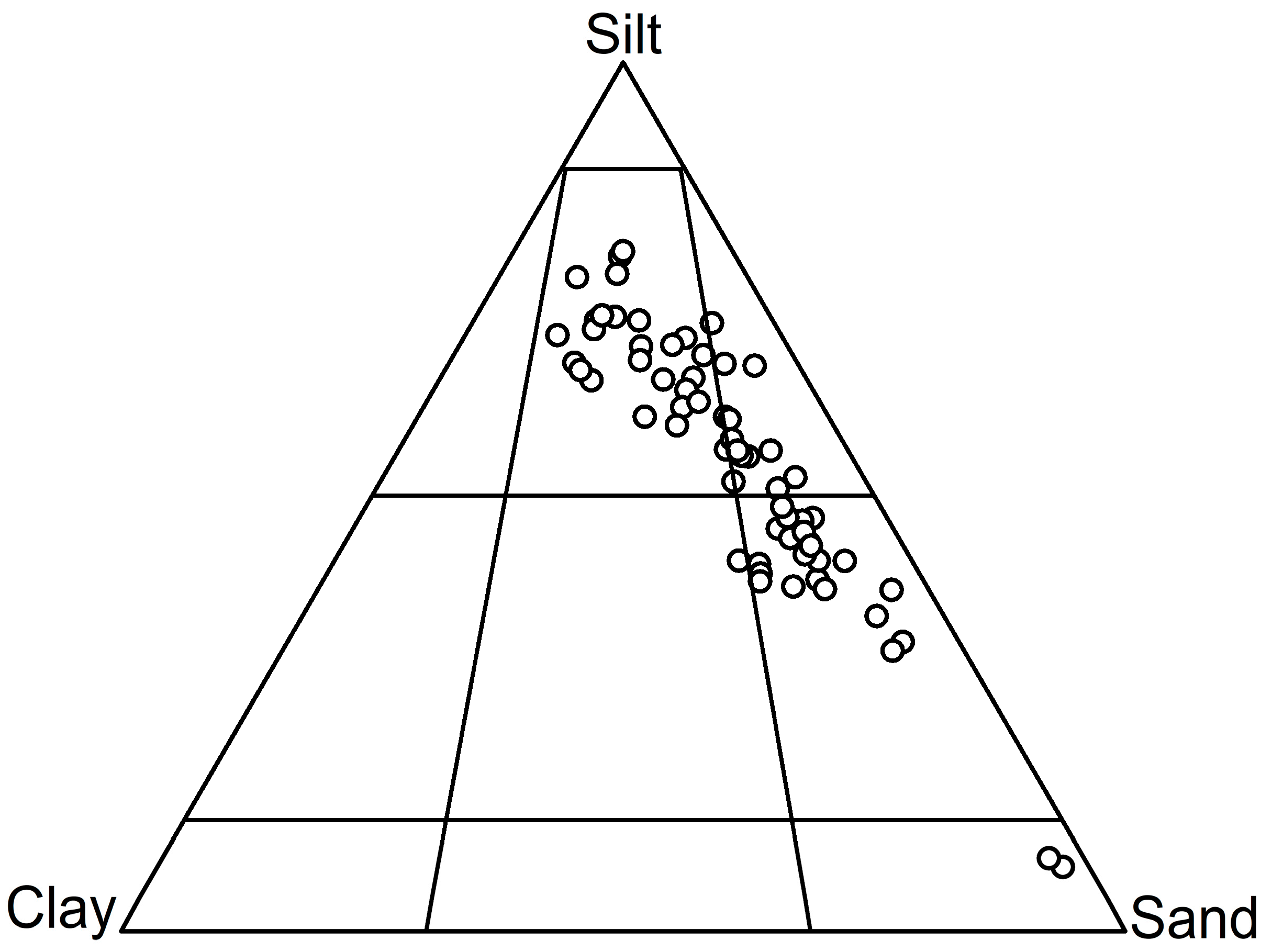
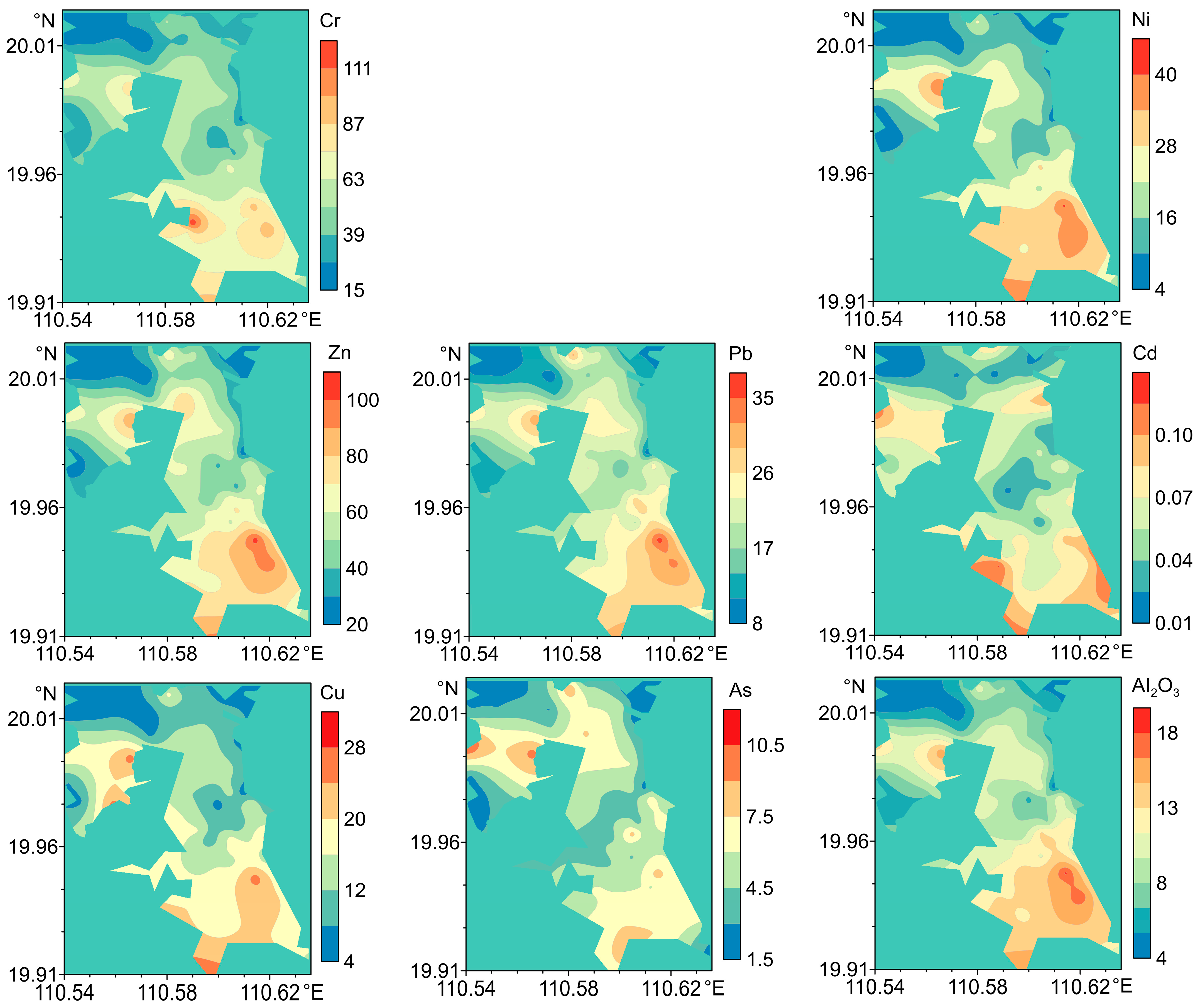
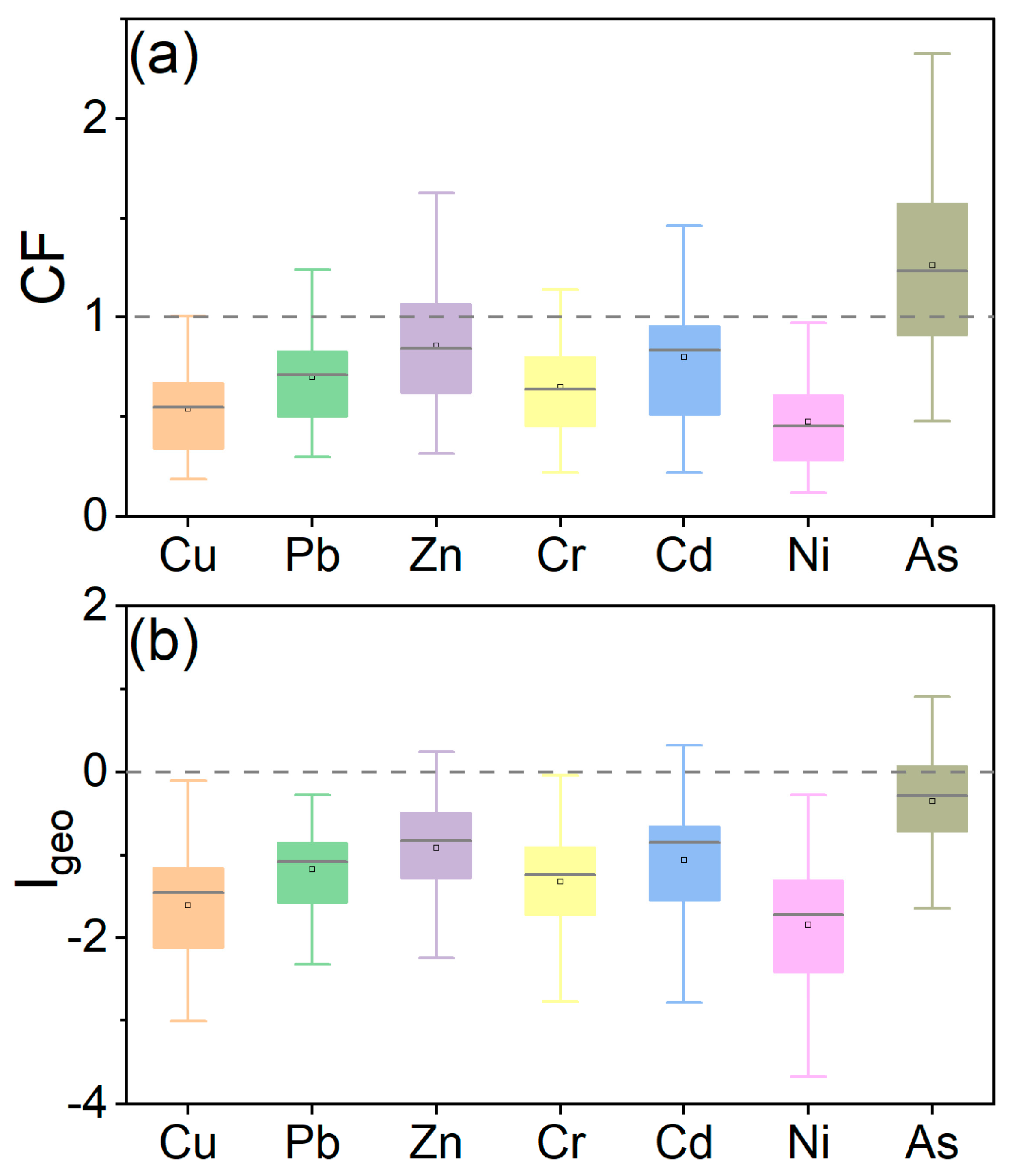
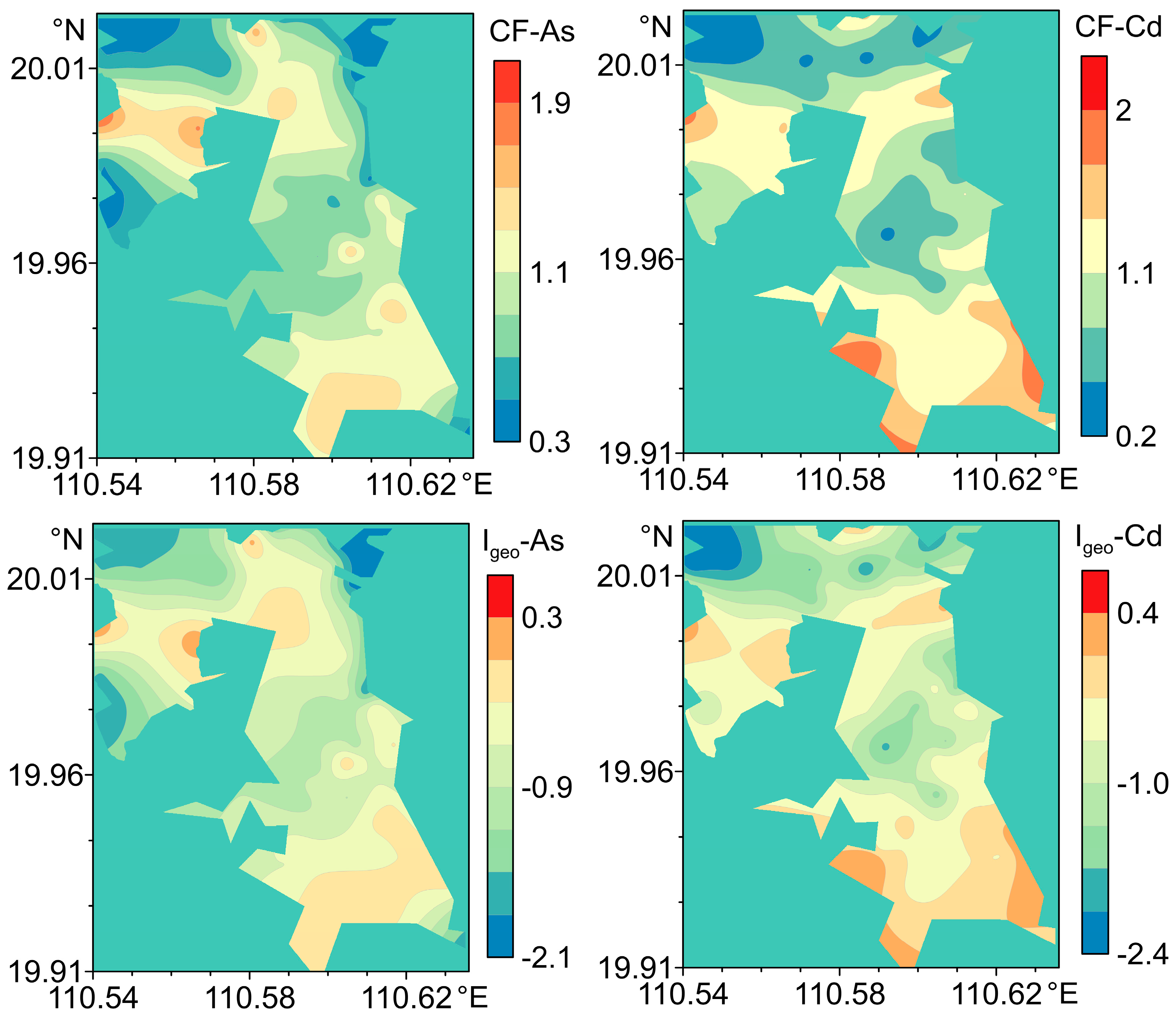

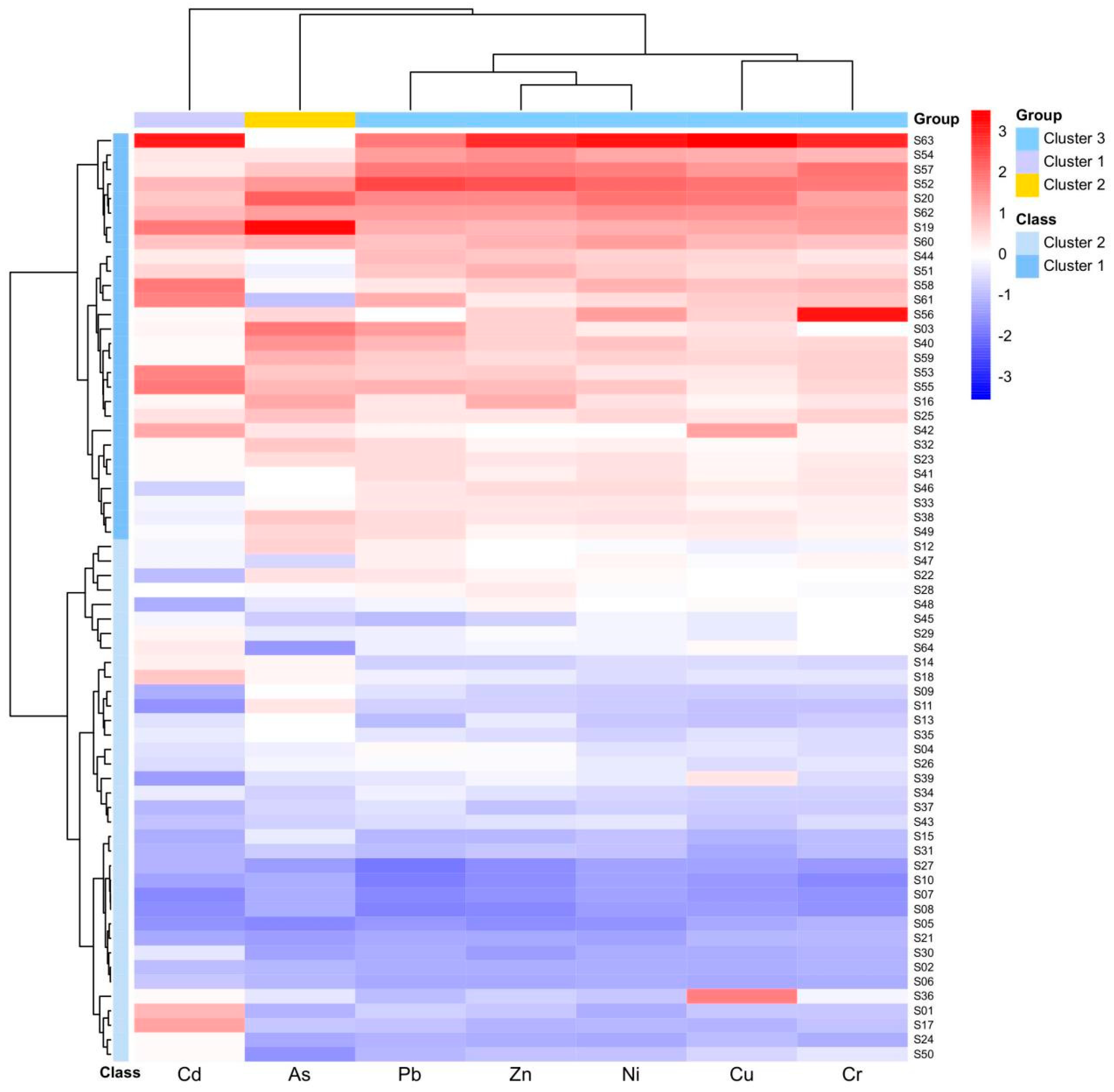
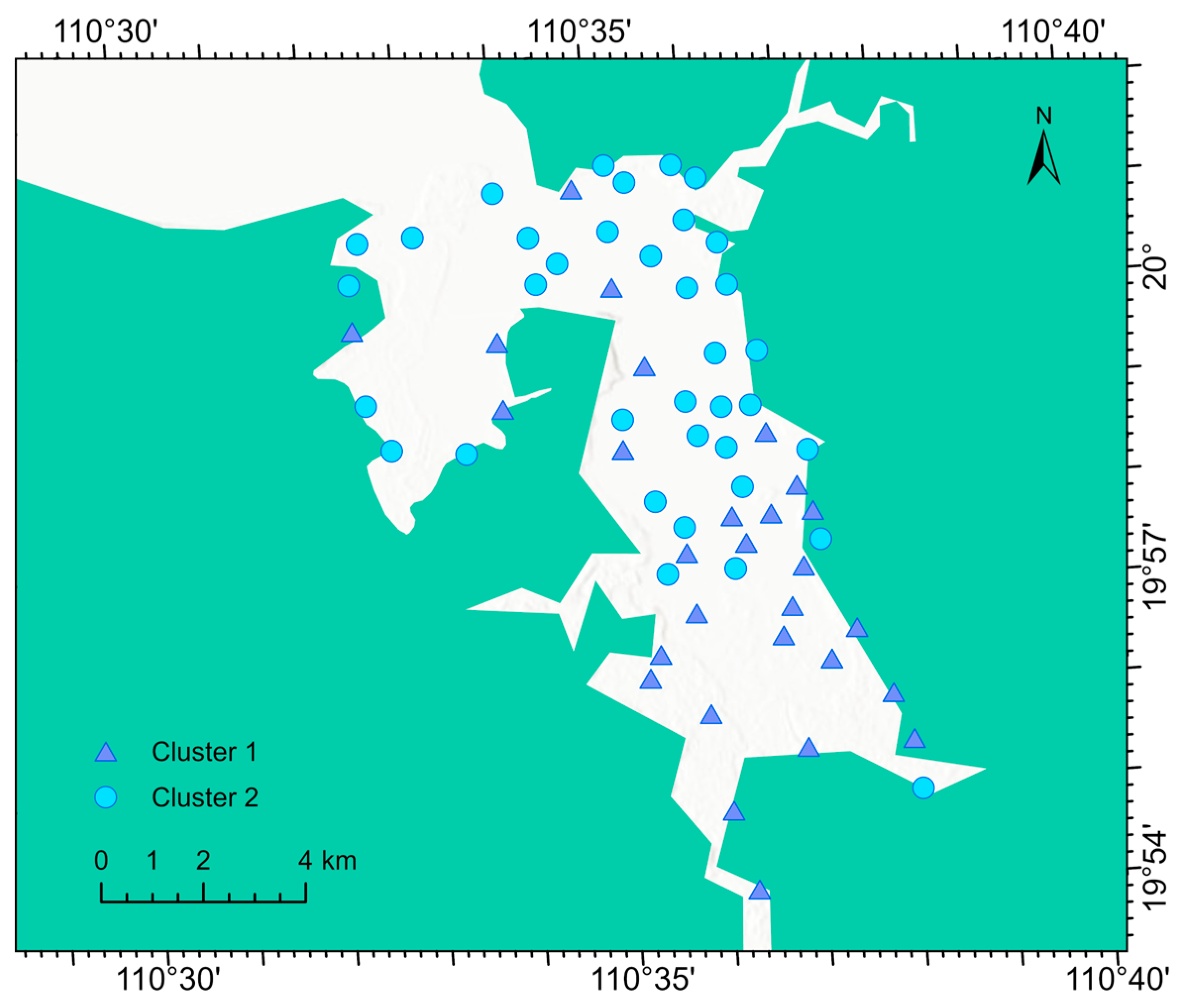
| Parameters | RI | |||||||
|---|---|---|---|---|---|---|---|---|
| Cu | Pb | Zn | Cr | Cd | Ni | As | ||
| Max | 9.08 | 6.27 | 1.93 | 3.68 | 74.40 | 8.71 | 21.01 | 112.46 |
| Min | 1.21 | 1.51 | 0.34 | 0.55 | 8.66 | 0.83 | 3.58 | 19.01 |
| Mean | 3.52 | 3.53 | 0.93 | 1.63 | 31.76 | 3.35 | 9.42 | 54.15 |
| Variables | Al2O3 | Cu | Pb | Zn | Cr | Cd | Ni | As | Sand | Silt |
|---|---|---|---|---|---|---|---|---|---|---|
| Cu | 0.880 ** | |||||||||
| Pb | 0.963 ** | 0.844 ** | ||||||||
| Zn | 0.963 ** | 0.894 ** | 0.955 ** | |||||||
| Cr | 0.913 ** | 0.882 ** | 0.847 ** | 0.908 ** | ||||||
| Cd | 0.675 ** | 0.706 ** | 0.659 ** | 0.671 ** | 0.684 ** | |||||
| Ni | 0.964 ** | 0.901 ** | 0.923 ** | 0.969 ** | 0.951 ** | 0.670 ** | ||||
| As | 0.692 ** | 0.629 ** | 0.760 ** | 0.732 ** | 0.643 ** | 0.463 ** | 0.711 ** | |||
| Sand | 0.065 | 0.005 | 0.078 | 0.084 | 0.061 | −0.035 | 0.103 | 0.163 | ||
| Silt | −0.022 | 0.043 | −0.048 | −0.052 | −0.015 | 0.07 | −0.053 | −0.137 | −0.974 ** | |
| Clay | −0.177 | −0.159 | −0.145 | −0.151 | −0.186 | −0.092 | −0.221 | −0.181 | −0.683 ** | 0.499 ** |
Disclaimer/Publisher’s Note: The statements, opinions and data contained in all publications are solely those of the individual author(s) and contributor(s) and not of MDPI and/or the editor(s). MDPI and/or the editor(s) disclaim responsibility for any injury to people or property resulting from any ideas, methods, instructions or products referred to in the content. |
© 2025 by the authors. Licensee MDPI, Basel, Switzerland. This article is an open access article distributed under the terms and conditions of the Creative Commons Attribution (CC BY) license (https://creativecommons.org/licenses/by/4.0/).
Share and Cite
Zhang, G.; Fan, J.; Wang, J.; Xue, G.; Ma, B.; Ruan, M.; Zhou, J.; Ling, W. Distribution, Sources, and Ecological Risk Assessment of Potentially Toxic Elements in Surface Sediments of Dongzhai Harbor, Hainan Island, China. Minerals 2025, 15, 349. https://doi.org/10.3390/min15040349
Zhang G, Fan J, Wang J, Xue G, Ma B, Ruan M, Zhou J, Ling W. Distribution, Sources, and Ecological Risk Assessment of Potentially Toxic Elements in Surface Sediments of Dongzhai Harbor, Hainan Island, China. Minerals. 2025; 15(4):349. https://doi.org/10.3390/min15040349
Chicago/Turabian StyleZhang, Gucheng, Jianxiu Fan, Jinli Wang, Guicheng Xue, Bo Ma, Ming Ruan, Jinbo Zhou, and Wenli Ling. 2025. "Distribution, Sources, and Ecological Risk Assessment of Potentially Toxic Elements in Surface Sediments of Dongzhai Harbor, Hainan Island, China" Minerals 15, no. 4: 349. https://doi.org/10.3390/min15040349
APA StyleZhang, G., Fan, J., Wang, J., Xue, G., Ma, B., Ruan, M., Zhou, J., & Ling, W. (2025). Distribution, Sources, and Ecological Risk Assessment of Potentially Toxic Elements in Surface Sediments of Dongzhai Harbor, Hainan Island, China. Minerals, 15(4), 349. https://doi.org/10.3390/min15040349







